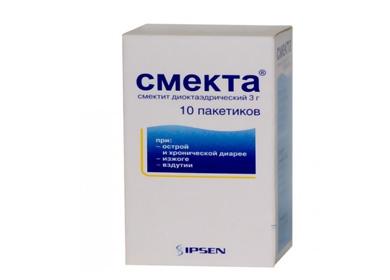The content of the article
In fact, silicates for Smecta have long been no longer produced in nature, but synthesized artificially, like more than 2/3 of the mineral compounds used by humans in various fields of life and production. But in the case of drugs, this is rather good than bad, since a chemically pure compound can only be obtained in laboratory conditions. And impurities with an unpredictable composition and action are clearly not needed by people in the body.
Action on the body
Dioctahedral smectite itself (a longer and more complex name for the same substance) is an enterosorbent. That is, Smecta is able to selectively bind and remove various microorganisms from the cavity of the digestive organs. This is not to say that Smecta acts so selectively, but the lion's share of what it eliminates is indeed the harmful components of the local “fauna” or food.
In addition, Smecta helps the mucus on the inner surface of the stomach and intestines to more densely envelop their walls. As a result, the drug prevents their contact with acid / alkali (a normal digestive environment, which becomes dangerous only when the mucous membrane is not secreted sufficiently), as well as:
- toxic components - caught in food or excreted by pathogens as waste products;
- bile acids - the inevitable components of intestinal digestion, which under certain circumstances (pathology of the liver and gall bladder) can even be in the stomach;
- foreign connections - in case of accidental ingestion of inedible inclusions (dust, stone chips, bark, soil, details of toys, which often happens with children).
Release forms and analogues
Smecta is made in the form of a powder for dilution with water, packaged in bags weighing 3 g each. In the form of a finished suspension, Smecta is not available. Analogues of the drug are:
- Neosmectin - in fact, another trade name “Smecta”;
- Activated carbon - both traditional black and “white”, which is dioxide of the same silicon plus auxiliary components;
- Enerosgel - Ukrainian-made preparation with methylsilicic acid based;
- Enterodez - Russian powder agent for the preparation of suspensions, the active substance of which is povidone (polyvinylpyrrolidone, a synthetic non-digestible polymer);
- Polysorb - a powder analogue of "White coal", as it also contains silicon dioxide.
Instructions for use "Smecta"
The range of indications for the use of "Smecta" is quite wide. Its main action is directed against diarrhea, but the drug in the form of a suspension is also prescribed:
- with nausea and vomiting;
- from heartburn;
- with rotavirus (intestinal flu);
- bacterial intestinal infections;
- bloating;
- from colic, especially in children;
- with gastritis and ulcer of the stomach / intestines;
- with a hangover syndrome (alcohol poisoning).
According to the manufacturer, pregnancy and breastfeeding do not create restrictions on taking Smecta, as it is not digested and not absorbed into the blood (and therefore into breast milk).
When given to newborns
"Smecta" is often prescribed for newborn jaundice - the active breakdown of fetal hemoglobin as it is replaced by "adult" red blood cells suitable for pulmonary respiration.
Red blood cells are destroyed with the release of a large amount of bilirubin into the bloodstream - a tan organic dye for feces and bile. And while it is in the blood, tissues and mucous membranes of the body acquire a characteristic yellowish tint. The liver is completely involved in the processing of bilirubin into bile and the removal of its excess with solid intestinal waste. But in newborns, its enzyme systems are not yet developed. Therefore, within a few days after childbirth, the baby's skin turns yellow.
Limitations and side effects
In general, the reviews of doctors about the use of Smecta confirm the universality and safety declared by the manufacturer, but - with the exception of the following cases.
- Chair delays. There is only one strict contraindication to taking Smecta in any dose - acute constipation, especially if it is caused by an obstruction of the intestine (helminths, swelling, as a result of intestinal torsion).
- Suspicious symptoms. The drug is also not recommended for taking longer than a week, if a digestive disorder is combined with vomiting, which is independent of meals, fever, defecation of almost unchanged food.
- Zero efficiency. The course of treatment with Smecta should be stopped all the more if during the week the symptoms from which it was taken have not disappeared, intensified, or new ones have been added to them. In this case, a visit to a gastroenterologist becomes mandatory.
- Individual intolerance. Smecta is also contraindicated in case of allergy to any components of the drug, including both diosmectite and excipients (especially flavorings).

The danger of aluminum salts
The presence of aluminum silicate in Smecta makes it possible to associate its potential harm with its accumulation in the body, especially with frequent or prolonged use. The problem is that various aluminum salts are part of a large number of personal care products, and the lion's share of antacids - means to eliminate heartburn. They form the basis of antiperspirants, are available in female mascara, toothpaste, face and body creams and so on.
It is not always about silicates, but always about aluminum derivatives. In small quantities, they are neutral in relation to our body and are even necessary for it for normal life. But taking into account such a number of their sources, including the uncontrolled intake of Smecta, excess in their body is increasingly common. At present, the relationship between an overdose of aluminum in the drugs used is already considered to be proven and:
- breast cancer
- Alzheimer's disease;
- disorders of the central nervous system, especially peripheral departments;
- reduced absorption of vitamins, minerals and trace elements;
- slowing down the development and renewal of bone tissue;
- degradation of the white and gray matter of the brain.
In addition, aluminum penetrates freely through the placental protective barriers and into breast milk, leading to defects in the development of the fetus. Some of these deviations are incompatible with life. That is why neither antiperspirants nor aluminum-based antacids are currently recommended for expectant mothers. And all products containing it sold on the territory of the EU countries must be provided with appropriate warnings on the packaging.
General treatment regimens for adults and children
As for how quickly Smecta acts in case of various violations of the digestive tract, you can not worry about it - quickly enough, within the next three to fifteen minutes (depending on which department the process is located in) . Adults are usually prescribed one packet of Smecta, three times a day, between meals in a diluted half glass of warm water. The dosage of "Smecta" in case of poisoning, especially acute, can be increased by a maximum of two - up to six sachets per day.
Answering the question of how to give Smect to a child, we recall the possible harm of the drug. But with the exception of this point, different dosage groups are shown to different age groups of children.
- Children under one year old. They are recommended to take no more than one sachet per day for three or more meals with food.
- Children from one to two years. They can be prescribed two bags (6 g) of Smecta, in three or four doses per day, along with food or complementary foods.
- Children over two years old. It is permissible for them to give two packets of “Smecta” per day or increase the dose to three, depending on the severity of the symptoms.
Children always drink medicine reluctantly, despite any vanilla-strawberry flavor and the presence of glucose. Therefore, the topic of how to breed Smecta in bags usually haunts parents. The best solution here is not to dissolve the liquid Smecta in water, but to choose dishes with a consistency that makes it possible to mask the admixture of Smecta powder well. For example, add the product to filtered breast milk, artificial formula, fruit purees and cereals, baby food, any semi-liquid / liquid complementary foods or drink, especially loved by the baby.

